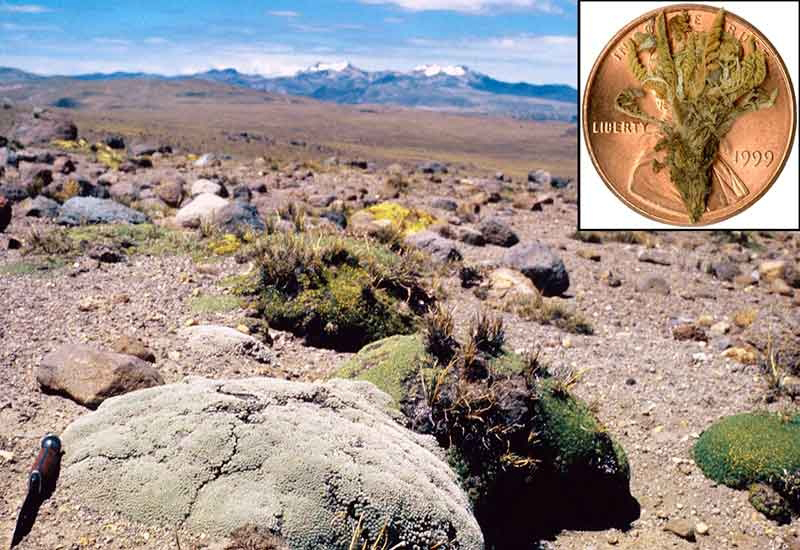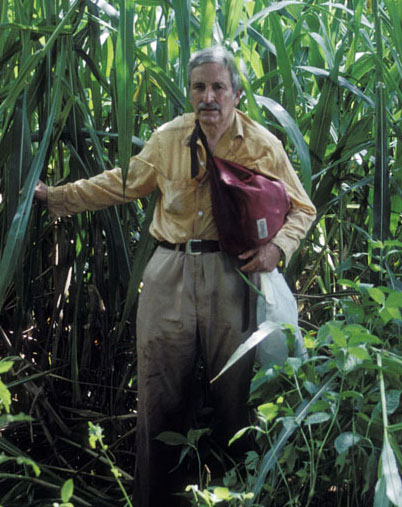A Small Violet and a Great Botanist
Posted in Science on August 7 2013, by NYBG Science
Scott A. Mori is the Nathaniel Lord Britton Curator of Botany at the The New York Botanical Garden. His research interests are the ecology, classification, and conservation of tropical rain forest trees. His most recent book is Tropical Plant Collecting: From the Field to the Internet.
Xavier Cornejo, a former Research Assistant at NYBG, is a curator of the GUAY Herbarium at the University of Guayaquil, Ecuador. His main research interests are the taxonomy of Neotropical Capparaceae and the conservation of mangroves and terra firme forests in western Ecuador.

Each year the Institute for Species Exploration of Arizona State University selects 10 species from among the estimated 18,000 new species of plants, animals, or fungi as the most interesting published in the previous year. In 2012, 140 species were nominated and only two of those selected were flowering plants—a miniature violet named Viola liliputana from the Peruvian Andes, and a species of the Myrtle family, Eugenia petrikensis from Madagascar.
We are especially pleased to see the violet selected because we know both of the authors: Harvey Ballard, now an Associate Professor at Ohio University, and Hugh H. Iltis, former Director of the Herbarium of the University of Wisconsin and research mentor to our research and Ballard’s alike. Hugh collected this spectacular violet nearly 50 years ago and was so impressed by the miniature high Andean plant that he took copious notes about the species, which was published in Brittonia by Springer for The New York Botanical Garden. We take this opportunity to recognize the accomplishments of Hugh Iltis in conservation and botanical science, and to thank him for the role that he has played in our careers.
Hugh Iltis is an avid plant collector famous for gathering large numbers of well-prepared plant specimens, a process he calls “baling hay.” He is also interested in the role that botanists play in discovering new species and improving the genetics of economic plants; his major contributions are based on his collections and research on corn, tomatoes, potatoes, and the caper family. For example, in December of 1962, Iltis and his Ph.D. student, the late Don Ugent (later a professor at Southern Illinois University in Carbondale), traveled to Peru to study species of wild potatoes as part of Ugent’s research. One of their serendipitous discoveries was a weedy tomato, with sweet, green-and-white berries slightly smaller than a cherry, which they collected and numbered as Iltis and Ugent 832. Iltis squeezed the seeds from the fruits and put them in a packet.
When he returned to Madison Iltis sent these seeds to Charles Rick, a renowned tomato geneticist at the University of California, Davis, who named it as a new species in 1976: Lycopersicon chmielewskii C.M. Rick, Fobes & M. Holle, in honor of a Polish tomato expert. In 1980, Iltis learned that Rick had crossed the progeny of 832 with cultivated tomatoes in an effort to improve the desirability of the commercial variety. The hybrid produced larger fruit with increased pigmentation and, most importantly, higher soluble sugar content. Rick informed Iltis that each 0.5% increase in sugar content was worth about eight million dollars a year (in 1987 dollars), an astonishing return on a modest $21,000 NSF grant.
Iltis also contributed to the debate on the evolution of corn (Zea mays L.). He and his collaborators described Zea diploperrenis in the prestigious journal Science in 1979. Corn is a perennial plant with a diploid chromosome number, and this combination of features led Iltis to believe that it could be hybridized with cultivated corn, an annual species, to produce perennial cultivated corn (not yet accomplished). Iltis also published another paper in Science titled “From Teosinte to Maize: The Catastrophic Sexual Transmutation,” in which he hypothesized that an ear of corn, which is the only cereal crop with a unisexual inflorescence, is the transformed, feminized central spike of the bisexual inflorescences found in teosinte (Zea mexicana (Schrad.) Kuntze). These theories, however, have been disputed by other scientists.

Iltis was also among the first modern biologists, along with Paul Erlich, to emphasize the negative impact that unrestrained human population growth was having on the natural world. He is a dynamic and inspirational speaker, as well as divisive, inspiring both admiration and disdain among his audiences for his stand against the destruction of nature and the “heretical” ideas he preaches. His feelings about man’s role in nature are encapsulated in the following excerpt from his writings:
“Mankind depends on plants for food, fiber, drugs—and a livable world. But more than that, our children will want nature to experience while growing up—to explore, love, and enjoy its beauty and diversity. Corn and cows, concrete and cars are not enough to sustain and empower a human psyche that until only a few generations ago lived in daily contact with a variety of plants and animals, a psyche that, winnowed and sifted by natural selection, is genetically programmed to respond positively to nature and its patterns. By destroying so much of the natural environment, we humans are now destroying crucial parts of our own psychological as well as physical habitat. For those in the know, it is a gloomy picture indeed.”
Iltis was an early advocate of nature protection in Wisconsin, and worked tirelessly alongside the Nature Conservancy to establish local reserves. In 2007, David and Shelly Hamel honored him by naming a 110-acre reserve (harboring sandy prairie, savanna, and a bog) the Iltis Prairie.
His studies of plants have led to habitat conservation nearly everywhere he has carried out fieldwork. For example, the discovery and description of a wild relative of corn, Zea diploperennis, inspired Mexican authorities in the state of Jalisco to establish the Las Joyas Biological Field Station of the Universidad de Guadalajara, and the 350,000-acre Reserva Biosfera de la Sierra de Manantlán, under the auspices of the state of Jalisco and the UNESCO Man in the Biosphere (MAB) program.
We are grateful to Hugh H. Iltis for the role he has played in establishing us as systematic botanists. He encouraged Mori to study the Brazil Nut Family (Lecythidaceae), and transferred his knowledge about the Caper Family (Capparaceae) to Cornejo. Hugh continues to inspire us with his dedication to botanical science and to the protection of all living things on Earth.


A most remarkable man indeed! Very few can make the leap from a tiny Andean violet to the world population explosion. The latter topic is still tragically considered moot, although side related issues, such as climate change, are only starting to be addressed. I had the privilege of hearing him speak once at a scientific meeting. Fortunately, he was last on the program because he went way overtime discussing the evolution of corn and then merging into the world population problem. This was back in the 1980s, but I still vividly remember the audience staying glued to their seat mesmerized by the talk. Hugh Iltis was not ahead of his time—just the rest of us are behind the times.